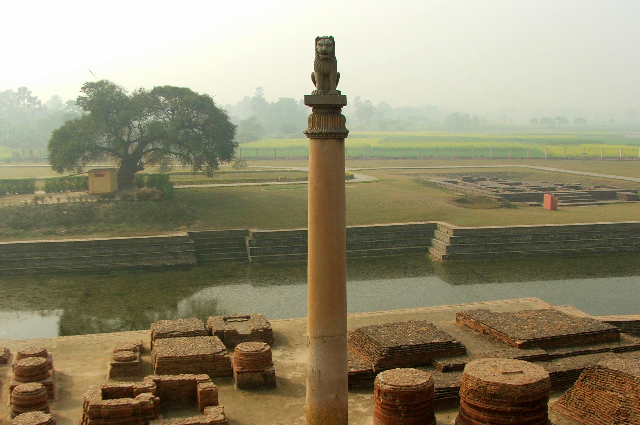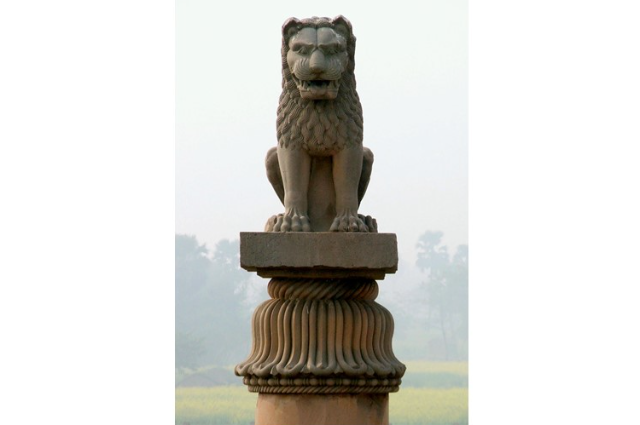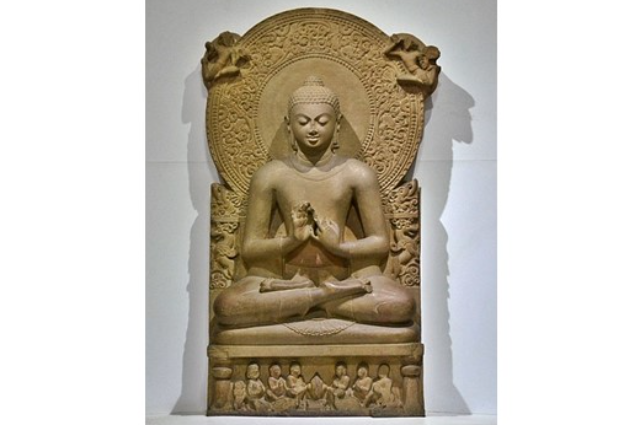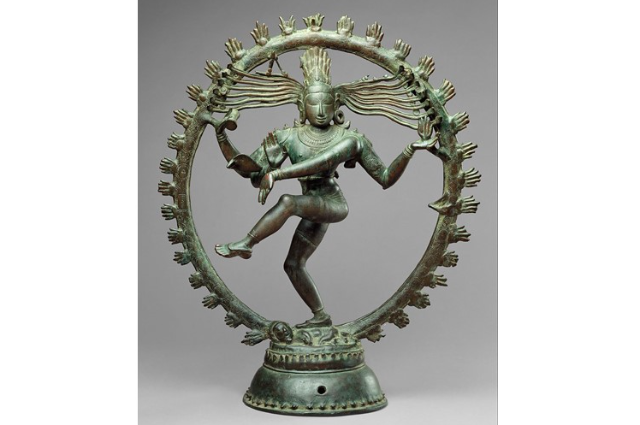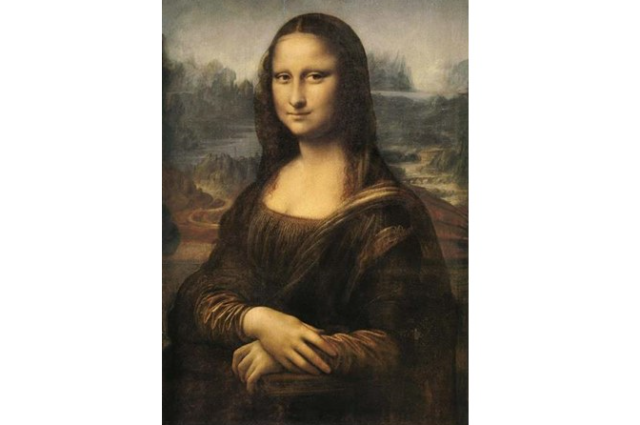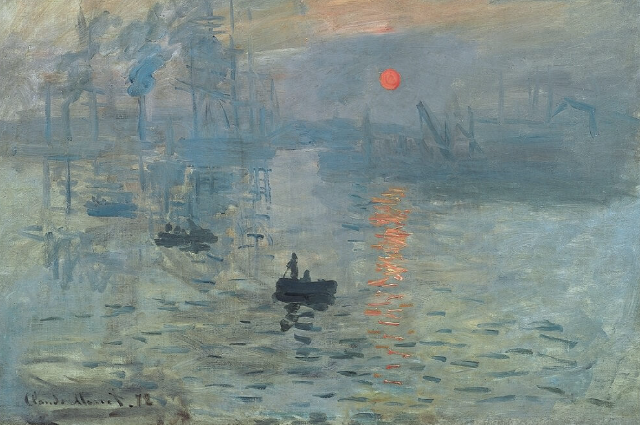Introduction
“Art is unquestionably one of the purest and highest elements in human happiness. It trains the mind through the eye, and the eye through the mind. As the sun colours flowers, so does art colour life”. - John Lubbock
One may argue that the educated classes' expertise and artistic expression surpassed their understanding and respect of religion at some point in the past several centuries. People still associate and follow a diversity of religions, including Catholicism, Judaism, and Islam, to name a few. Many others, on the other hand, may regard art with religious reverence. While commissioned public art has long been a part of our culture, it now appears to be more prevalent than ever. In this Blog, we will be covering various open space artworks in the form of sculptures and paintings placed to draw inspiration and meant to draw more public admiration towards art.
The Great Sphinx of Giza:
The Great Sphinx of Giza is a massive limestone statue of a reclined sphinx at Giza, Egypt, that shows King Khafre's face and is thought to date from the time of King Khafre (c. 2575–c. 2465 BCE). It is undoubtedly the best-known example of sphinx art and one of Egypt's most iconic sites. With a stretch of 240 feet (73 metres) and a height of 66 feet (20 metres), the Great Sphinx is one of the world's largest sculptures. It has a lion's body and a human head with a royal crown on it. The Great Sphinx was carved from a single block of limestone, and pigment residue shows that it was painted entirely. According to some estimations, the statue would have taken 100 artisans three years to complete using stone hammers and copper chisels.
The Great Sphinx is attributed to Khafre by most experts, who date it to the 4th dynasty. Some say it was erected by Khafre's older brother, Redjedef (Djedefre), to honour their father, Khufu, whose Giza pyramid is known as the Great Pyramid. Some analysts claim that the Great Sphinx's face resembles Khufu more than Khafre's, and that this finding led to conjecture that Khufu created the statue himself.
The Terracotta Army:

Source: Manoj kumar kasirajan on Unsplash
The Terracotta Army was built to serve as an afterlife guard for China's First Emperor's tomb. Thousands of realistic life-size terracotta soldier sculptures depict the guard forces of Shihuang's first emperor, Qin Shi Huang. They were assembled and painted after being moulded in sections and burned. In Xi'an, the Terracotta Army Museum is a must-see. It is regarded as one of the most important archaeological destinations in the world, as well as one of the most significant developments of the twentieth century.
The deepest and most stunning pit is Pit 1, which is the size of an aeroplane hangar. It is thought to include approximately 6,000 terracotta soldiers and horses, although only about 2,000 are on display. Pit 1 is where the most spectacular Terracotta Army photographs were captured. In a rectangular formation, all soldiers and horses face east, each with a long spear, dragger, or curved sword. Three rows of troops appear to form the vanguard at the army's easternmost end. The main group of armoured warriors with weaponry, backed by 38 horse-drawn chariots, is close behind.
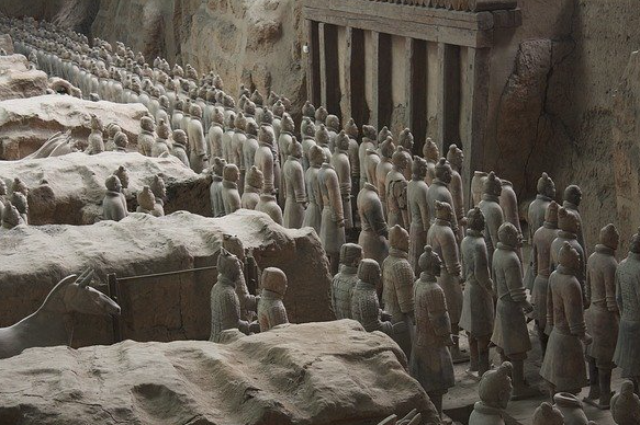
Source: aejbailey from Pixabay
One row of figures serves as the army's defence wing on the southern, northern, and western sides. Situated in front of such a massive ancient army formation, one could feel the ground tremble as the men advanced. Every figure has unique facial characteristics and expressions, as well as dress, hairstyles, and movements, providing a wealth of rich artefacts for the research of that period's military, cultural, and economic history. In 1979, the vault was exposed to the public. It is approximately 210 metres long and 62 metres wide, with a depth of 4.5 metres to 6.5 metres below ground level. Ten earthen barriers were created at 2.5 metre intervals to form nine circle pathways.
Christ the Redeemer:
Christ the Redeemer, also known as Cristo Redentor in Portuguese, is a massive statue of Jesus Christ that stands near Mount Corcovado in Rio de Janeiro, Brazil. Corcovado towers over Rio de Janeiro, Brazil's main port city, and is memorialized in famous traditional music. The Christ the Redeemer sculpture, which rises 98 feet (30 metres) tall with 92 feet of horizontally outstretched arms, was finished in 1931. The statue has become a symbol for both Rio de Janeiro and the entire country of Brazil.

The statue, which is formed of concrete blocks and covered in a mosaic of thousands of triangular soapstone tiles, is mounted on a square stone pedestal base that stands about 26 feet (8 metres) tall and sits on a platform above the mountain's peak. The sculpture is the world's largest Art Deco-style sculpture.
Tian Tan Buddha:
Tian Tan, often known as 'The Big Buddha,' is a massive bronze statue on Lantau Island that stands near to the secluded Po Lin Monastery. Since its installation in 1993, it has been a prominent tourist attraction and is the world's second-largest outdoor seated Buddha.

Source: Jason Cooper on Unsplash
Around the Eastern Han time, Buddhism was spread to China, bringing with it Buddha sculptures and other artefacts. As sculptural artwork improved over time, Buddhist arts expanded, reaching new heights and educating many people. The monks were invited to visit the mainland in 1979, after the Po Lin Monastery was awarded property on which to create their own statue. The sculptures they saw inspired them, and they eventually decided to erect a Buddha statue in Hong Kong. After witnessing the Altar of Heaven in Beijing, which bears the same name, the name Tian Tan was born.
It took 12 years to build and is designed to represent a respectful relationship between man and nature. To get up front and personal with it, you must first climb the 268 stairs that lay ahead of it. This climb to the summit will not only allow you to experience Tian Tan up close, but it will also eventually bring in the mountain and sea views that can be seen from the statue's base.
Mount Rushmore:
Gutzon Borglum's Mount Rushmore National Memorial is a large-scale mountain sculpture. George Washington, Thomas Jefferson, Abraham Lincoln, and Theodore Roosevelt, four of America's most distinguished presidents, symbolize 150 years of American history. The shrine sits about 30 miles from Rapid City in the Black Hills of South Dakota, near Keystone.

Roughly three million people visit Mount Rushmore each year from all over the world to see this patriotic landmark. The mountain's majesty is still felt by every visitor today. The presidents' four "great faces" rise 5,725 feet above sea level and are suited to men standing 465 feet tall. The Mount Rushmore Audio Tour, the Lincoln Borglum Visitor Center & Museum, and other attractions are available at the site.
Cloud Gate:
Cloud Gate is the first public outdoor piece by British artist Anish Kapoor to be displayed in the United States. The 110-ton circular artwork is made out of a sequence of streamlined stainless steel plates that resemble Chicago's famed skyline and the skies above it. Visitors can touch the sculpture's mirror-like exterior and see their image reflected back from a variety of angles thanks to a 12-foot-high arch that serves as a "gate" to the concavee chamber beneath it.

The artwork, which is 66 feet long by 33 feet high and was driven by liquid mercury, is one of the world's largest of its sort. The AT&T Plaza, where Cloud Gate is located, was facilitated by a gift from AT&T. Millennium Park is in the heart of Chicago's downtown district. It is bounded on the west by Michigan Avenue, on the east by Columbus Drive, on the north by Randolph Street, and on the south by Monroe Street.
People have moved to it in massive numbers since its introduction in 2006 to appreciate the reflection of the Chicago skyline and, in more recent years, to take selfies. The piece, which is made out of 168 stainless steel plates, was unveiled in 2006.
Moai:
Easter Island's Moai statues are huge megaliths that are the island's most famous feature. The residents of this island, also known as Rapa Nui, created the moais between 1400 and 1650 A.D. They're commonly referred to as the Easter Island heads. This is a complete fallacy based on images of statues partially hidden in soil on the volcano Rano Raraku. The truth is that each of these "heads" has a whole body.
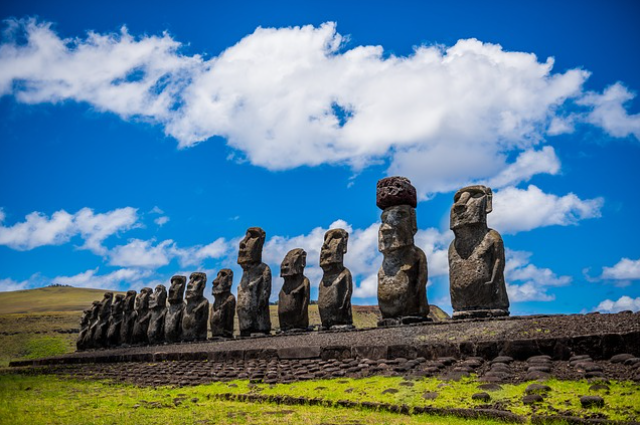
Source: Yerson Retamal from Pixabay
There are about 1000 statues, weighing up to 86 tonnes and standing up to 10 metres tall, while the average is about half that. The volcano Rano Raraku provided 95 percent of the moais. This site was chosen because it contains a lot of tuff, which is what the moais from this volcano are made of. Tuff is packed volcanic ash that is easy to cut, which was important because the locals lacked modern tools and relied solely on stone tools, known as toki.
Moai sculptures were erected to commemorate the deaths of chieftains and other notable persons. They were put atop ahu, which are rectangular stone foundations that serve as tombs for the persons the statues symbolize. The moais were purposefully created with varied traits in order to maintain the appearance of the person they portrayed.
The statues were purchased from a single group of carvers. The tribe that was purchasing would pay with whatever they had in great quantities. Sweet potatoes, poultry, bananas, carpets, and obsidian tools are examples of trading items. Because a larger statue entails a higher price, larger statues would also imply greater glory for the tribe, as it would demonstrate that the tribesmen are intelligent and hardworking sufficient to pay.
The Motherland Calls:
The Motherland Calls was the world's greatest sculpture when it was displayed in 1967. It has since lost that title, but it is still the largest in Europe. The 279-foot-tall monument depicts a woman striding forward while flashing her sword, sculpted by Yevgeny Vuchetich and Nikolai Nikitin. She is a well-known Russian figure who may be spotted near the battlefronts where the Battle of Stalingrad took place during World War II. Each of the 200 steps from the area's base to the statue's foot represents a day of the brutal 200-day struggle.

The Motherland Monument is widely regarded as one of Russia's most significant statues. It made a significant contribution to the country's political identity. When the Battle of Stalingrad was being waged in 1942, German soldiers invaded what is now known as Russia's Mamayev Kurgan Park. This was done in order to gain control of the Soviet Union. This horrific struggle is inscribed in history's books since it lasted 5 months, a week, and 3 days of nonstop warfare, combat fighting, and air raids. It spilled the blood of thousands of soldiers, leaving the country in grief.
The Battle of Stalingrad was fought in order for the Axis powers to gain complete control of Stalingrad's industrial belt, as well as to stop the Volga River, which was then used for artillery supply and shipping oil. After a deadly fight that lasted months, the Russian army took control of the attacks with Operation Uranus, a series of counter-attacks. This action aided the Russian army in gaining control of the situation, ultimately weakening the German army in 1943.
Ashoka Pillar, Sarnath, 3rd Century BC:
Emperor Ashoka built the most famous capital (the four-lion one in Sarnath, Uttar Pradesh) around 250 BC, commonly known as the "Ashoka Column." Back to back, four lions are seated. The Lion Capital is now displayed in the Sarnath Museum, but the Column continues in its original location. The National Emblem of India was chosen from this Lion Capital of Ashoka from Sarnath, and the wheel "Ashoka Chakra" from its base was located at the center of the Indian flag.
One of Ashoka's first artistic projects was to create the pillars that can now be found all around the Mauryan kingdom. The pillars range in height from 40 to 50 feet. They're made of two sorts of stone: one for the shaft and another for the capital. Almost all of the shafts were made from a single piece of stone. Workers cut and carried the stone from mines in Mathura and Chunar, both in Ashoka's kingdom in northern India. Each of the pillars weighs roughly 50 tonnes. Only 19 of the original pillars are still standing, and several of them are in parts. In the sixteenth century, the first pillar was revealed.
The pillars' architectural design emphasises the Buddhist philosophy. Animal designs atop the majority of the pillars. Each pillar is also topped by an asymmetrical lotus flower, which is Buddhism's most widely recognised symbol (a lotus flower rises from muddy water to bloom unblemished on the ground, the lotus became an application for the Buddhist professional, who, despite the difficulties of daily life and the never-ending cycle of birth and rebirth, was possible to accomplish Liberation, or the understanding of how to be free of samsara, by having to follow the Four Noble Truth. The capital, or uppermost part of a pillar, is made up of this flower and the animal that stands on top of it. The majority of pillars are topped with a single seated or standing lion or bull.
Buddha Statue, Sarnath:
In the deer park near Sarnath, there is a sculpture of Gautama Buddha giving his first sermon. The Four Noble Truths, the Middle Path, and the Eightfold Path were all proclaimed by him. He is seated in Padmasana with his right hand twisting the Dharmachakra and resting on a Triratna symbol, supported on either side by a deer in the statue.
Sarnath is one of the finest Buddhist places in the world, as it is the site of Gautama Buddha's first discourse. It remains a centre of deep knowledge, a site of devotion, and a vihara (monastery) for monks and students for approximately 1,700 years, from then until the 12th century CE.
Sarnath was once known as 'Isipatana,' 'where the holy men arrived,' in the early Buddhist Pali literature, and 'Mrigadava,' or 'deer park,' just 10 km north-east of Varanasi, near the confluence of the Ganga and Varuna Rivers in Uttar Pradesh. According to tradition, a Bodhisattva transformed into a deer and donated his life to a king rather than the doe that the latter was about to slaughter. The king was so affected that he established the area as a deer sanctuary.
Nataraj, Chola Bronze Sculpture:
Shiva Nataraja is a wonderful creation as a symbol. It expresses the Indian philosophy of the never-ending cycle of time by combining Shiva's duties as creator, preserver, and destroyer of the cosmos in one figure. Although it first emerged in sculpture in the fifth century, it took on its current, civilization appearance during the Cholas' reign. Shiva's dance is encircled by a fiery halo. The damaru is held by the god in his upper right hand (hand drum that made the first sounds of creation). Agni is held in his upper left hand (the fire that will destroy the universe). He creates abhayamudra with his lower right hand (the gesture that allays fear). Apasmara Purusha is the dwarf-like figure having trodden by his right foot (illusion, which leads mankind astray). Shiva's front left hand, pointing to his lifted left foot, represents a sense of security for the distressed soul.
His hair flies to the sides as a result of the excitement of his movement. The symbols signify that Shiva's devotees can attain salvation by believing in him. This poised Nataraja sculpture dates from the medieval era and was created in South India in the 12th century CE under the patronage of the Chola Dynasty. It measures 96.0 cm in height, 82.8 cm in width, and 28.2 cm in depth. It is presently on display in the Chola Bronzes gallery at the National Museum in New Delhi.
Most famous masterpieces around the worldwide
While talking about famous sculptures and artworks, we can't forget the importance of paintings that had turned out to be masterpieces and recognised as a source of inspiration for many artists as well.
When evaluating the best-renowned paintings of all time, it's important to remember that painting is an ancient art form that dates back 40,000 years, when early humans used ochre and charcoal to make representations of animals or stencils of their own handprints on cave walls. It was, in other words, present at the dawn of cognitive processing, some 35,000 years before the written word.
Leonardo Da Vinci, Mona Lisa, 1503–19:
Mona Lisa, also known as Portrait of Lisa Gherardini, wife of Francesco del Giocondo, Italian La Gioconda, or French La Joconde, is a Leonardo da Vinci oil painting on a poplar wood panel that is widely considered to be the most renowned artwork in the world. It was painted in Florence between 1503 and 1519, and it now resides in the Louvre Museum in Paris, where it has maintained a pilgrimage site till the twenty-first century. The painting has sparked continuous interest and study due to the sitter's intriguing smile and her unknown identity.
The painting depicts a woman in a half-length portrait against a beautiful landscape. However, this basic explanation of what appears to be a normal composition does not convey the magnitude of Leonardo's achievement. The three-quarter view, in which the sitter's stance primarily faces the viewer, broke away from the usual profile attitude employed in Italian art and swiftly became the standard for all portraits, lasting well into the twenty-first century.
Leonardo's mastery of sfumato (fine shading) and his awareness of the physique and skull beneath the skin are evident in the subject's delicately sculpted face. Leonardo's precise inspections and endless patience are evident in the delicately painted veil, perfectly crafted tresses, and painstaking representation of folded linen. Furthermore, the sensual curves of the sitter's hair and attire are mirrored in the valleys and rivers behind her.
Vincent van Gogh, The Starry Night, 1889:
One of Dutch artist Vincent van Gogh's most famous pieces is The Starry Night, a fairly abstract landscape painting (1889) depicting an artistic night sky over a little hillside settlement.
A night sky swirling with chromatic blue swirls, a dazzling yellow crescent moon, and stars depicted as radiating spheres dominating the oil-on-canvas artwork. One or two flame-like cypress trees tower over the foreground to the left, their dark branches curving and swinging in response to the motion of the sky that they partially conceal. An organized settlement sits in the background in the lower right of the canvas among all of this activity. The modest houses and the slender spire of a church, which shines as a beacon against beautiful blue hills, are made out of precise regulated lines.
Several months after experiencing a breakdown in which he chopped a section of his own ear with a razor, Van Gogh painted The Starry Night in his 12-month confinement at the Saint-Paul-de-Mausole institution near Saint-Rémy-de-Provence, France. He sketched in spurts of production that contrasted with bouts of melancholy while at the asylum. Van Gogh was constrained to the elements that surrounded him as an artist who liked painting from observation—his own likeness, views beyond his studio window, and the surrounding landscape.
Eugène Delacroix, Liberty Leading the People, 1830:
Liberty Leading the People is an oil painting by French artist Eugène Delacroix from 1830 remembering the July Revolution in Paris, which deposed Charles X, the restored Bourbon king. The heroic picture of insurrection got mixed reviews at first, but it went on to become one of Delacroix's very famous paintings, serving as a symbol of the July Revolution and justifiable revolt.
After observing the violent development of demonstrations under a collection of strict legislation imposed by Charles X on July 26, 1830, Delacroix began painting. Working- and middle-class citizens erected roadblocks in Paris streets and resisted the royal army for three days, afterwards called as Les Trois Glorieuses (July 27–29). Charles X resigned after failing to quell the uprising. The so-called Citizen King, Louis-Philippe, ascended to the throne and established a constitutional monarchy. Delacroix's reliance on imperial commissions may have hindered him from directly participating in the uprising, but he was affected strongly when he witnessed insurgents raise the Tricolour, the French national flag, on Notre Dame, a key moment in the rebellion, according to historians.
Claude Monet, Impression Sunrise, 1874:
Impression Sunrise is a well-known artwork based on a scene in the port of Le Havre. A mist is shown by Monet, providing a hazy backdrop to the picture situated on a French bay. The orange and yellow colours contrasted well with the dark vessels, which reveal little, if any, texture to the viewer. The smaller boats in the front are seemingly driven along by the flow of the water in this powerful and realistic work. Separate brushstrokes were used to achieve this, which also depict distinct hues "sparkling" on the sea.
From April 15th to May 15th, 1874, Monet displayed his work alongside Camille Pissarro, Alfred Sisley, Édouard Manet, Paul Cézanne, Edgar Degas, and a group of thirty other artists. Because they were frequently rejected by the Paris Salon, they decided to establish their own exhibition. The majority of visitors were disgusted, if not angered, by the graffiti. The most popular painting on display was Monet's Impression, Sunrise, and some people stated they had no idea what they were seeing.
Conclusion
Since it's a Blog Post we were able to cover some limited sculptures, Artforms and paintings. Apart from these there have been many great art forms in all over the world one such example will be Indian artworks; to quote a few would be Madhubani Paintings, Pattachitra, Mysore Painting, Tanjore Paintings, Rajput Painting, Gond Painting, and many others.
For most individuals, art is a way of expressing or conveying things that we are unable to express or convey ourselves. It invokes feelings of joy, melancholy, rage, and grief through its visual form. That is why artwork is so crucial in bringing the final piece of the puzzle together, which is our perception. The artwork comes to life through our viewpoint as it shifts for each person who passes by. Art evaluation and analysis are vital because they help us appreciate art in terms of how it attracts us and what it represents to each individual. It digs into the history and background of the art, as well as the lives of the artists.
. . .
Reference:
- www.britannica.com/topic/Great-Sphinx
- blog.musement.com/us/famous-sculptures-around-the-world/
- www.chinahighlights.com/xian/terracotta-army/
- www.britannica.com/topic/Christ-the-Redeemer
- theculturetrip.com/asia/china/hong-kong
- www.blackhillsbadlands.com/parks-monuments
- www.chicago.gov/city/en/depts/
- www.easterisland.travel/easter-island
- blog.musement.com/us/famous-sculptures-around-the-world/
- www.artzolo.com/blog/famous-historic-sculptures
- smarthistory.org/the-pillars-of-ashoka/
- www.livehistoryindia.com/story
- www.metmuseum.org/art/collection
- indianculture.gov.in/artefacts-museums
- www.timeout.com/newyork/art/top-famous-paintings
- www.britannica.com/topic/Mona-Lisa-painting
- www.britannica.com/topic/The-Starry-Night
- www.britannica.com/topic/Liberty-Leading-the-People
- www.claude-monet.com/impression-sunrise.jsp
- leverageedu.com/blog/traditional-art-forms-of-india/
- www.educationworld.in/the-importance-of-art
- www.architecturaldigest.com/gallery
- cravepainting.com/blog/quotes-about-art


